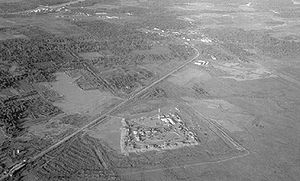- Operation Speedy Express
-
Operation Speedy Express Part of the Vietnam War 
Fire Support Base Danger, headquarters of an element of the 1st Brigade, 9th U.S. Infantry Division, Dinh Tuong Province.Date December 1968 to May 11, 1969 Location Mekong Delta provinces Dinh Tuong, Kien Hoa and Go Cong, Republic of Vietnam Result U.S victory (officially) Belligerents  United States
United States Viet Cong
Viet CongCommanders and leaders Julian J. Ewell Unknown Strength 8,000+ Undetermined Casualties and losses 40 killed and 312 wounded[1] 10,889 killed according to Gen. Ewell[1] Possibly more than 5,000 civilians killed Operation Speedy Express was a controversial United States military operation of the Vietnam War conducted in the Mekong Delta provinces Kien Hoa and Vinh Binh. The operation was launched to prevent NLF (Viet Cong) units from interfering with pacification efforts and to interdict lines of NLF communication and deny them the use of base areas.
Contents
Operation
In 1969 the 1st Brigade, 9th U.S. Infantry Division continued the operation in Dinh Tuong Province, using night ambush tactics while the 2nd Brigade continued its mission with the Mobile Riverine Force. Although engagements in the Operation Speedy Express were typically small, the 9th Infantry Division fought several sizeable engagements.[2] The objective was summarized by a U.S army publication to take the "war to the enemy in the Delta and sever his supply lines from Cambodia".[1]
The U.S. military used 8,000 infantrymen, 50 artillery pieces, 50 helicopters and extensive aerial bombardment. The United States Air Force carried out 3,381 tactical air strikes by fighter bombers.
Controversies
The U.S. military claimed 10,889 enemy dead, with only 40 soldiers killed in this operation from the period of December 1968 to 31 May 1969 (a kill ratio of 272.2:1), but only 748 weapons were recovered (a ratio of enemy killed to weapons seized of 14.6:1). The U.S. Army after-action report attributed this to the fact the high percentage of kills made during night hours (estimated at 40%), and by air cavalry and other aerial units, as well as admitting that "many of the guerilla units were not armed with weapons". The commander of the 9th Division, Julian Ewell, was allegedly known to be obsessed with body counts and favorable kill ratios and said "the hearts and minds approach can be overdone....in the delta the only way to overcome VC control and terror is with brute force applied against the VC".[3]
The operation caused controversy when in 1972 Kevin Buckley, writing for Newsweek in the article "Pacification's Deadly Price", questioned the spectacular ratio of U.S. dead to claimed NLF (Vietcong) as well the low number of weapons recovered, and suggested that perhaps over 5,000 were innocent civilians (quoting an unnamed U.S. official). Although Buckley acknowledged the NLF structure and control in the region was extensive, he wrote that local hospitals had treated more wounds caused by U.S. firepower rather than the NLF.[4]
It has also been alleged [5] that some U.S. commanders on the ground inflated the body count during the operation since this was how their success was judged.[6]
References
- ^ a b c http://www.transchool.eustis.army.mil/lic/documents/231st%20Trans%20Co.doc
- ^ Named Campaigns - Vietnam
- ^ Guenter Lewy book: America in Vietnam. 1980. Page 142. ISBN 0-19-502732-9.
- ^ Kevin Buckley Pacification’s Deadly Price, Newsweek¸ June 19, 1972, pp. 42-3. Buckley's statements were based on extensive interviews conducted by him and his associate Alexander D. Shimkin, who was fluent in Vietnamese. See Nick Turse, "A My Lai a Month," The Nation, November 13, 2008.
- ^ Former Senator Charles Hagel of Nebraska, a veteran of the Ninth Infantry, said, "You used that body count, commanding officers did, as the metric and measurement as how successful you were...." Quoted by Washington Post reporter Patricia Sullivan in a blog posting, "A Vietnam War That Never Ends," August 5, 2009. (Accessed August 17, 2011.)
- ^ Guenter Lewy book: America in Vietnam. 1980. Page 143. ISBN 0-19-502732-9.
See also
- Alexander D. Shimkin
- Winter Soldier Investigation
- Tiger Force
- Phoenix Program
- Pentagon Papers
- Russell Tribunal
- My Lai Massacre
- Operation Wheeler/Wallowa
- Vietnam War Crimes Working Group Files
- War crimes committed by the United States
- Human Rights Record of the United States
Further reading
- John Pilger: Heroes, Jonathan Cape, Australia, 1986. ISBN 978-0896086661
Categories:- Battles involving Vietnam
- 1968 in Vietnam
- 1969 in Vietnam
- Battles and operations of the Vietnam War
- Battles involving the United States
Wikimedia Foundation. 2010.
